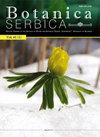在塞尔维亚首次发现Haslea Simonsen属,并在伏伊伏丁那省极端和独特的栖息地为该国的植物群发现新的硅藻分类群
IF 1.1
4区 生物学
Q4 PLANT SCIENCES
引用次数: 3
摘要
从奥地利到匈牙利,再到塞尔维亚的伏伊伏丁那省,盐的栖息地是极端而独特的环境。在本研究中,我们调查了8个盐沼生境(通道盐沼、湿盐草甸和盐沼),收集了浮游生物、浮游硅藻和附生硅藻。记录了塞尔维亚硅藻区系新发现的17个硅藻类群。此外,在塞尔维亚首次记录到Haslea属,其中有1种(H. spicula)。所鉴定的分类群在样品中是零星的或罕见的。本文章由计算机程序翻译,如有差异,请以英文原文为准。
First finding of a genus Haslea Simonsen in Serbia and new diatom taxa for the country's flora in extreme and unique habitats in the Vojvodina Province
Salt habitats are extreme and unique environments found from Austria through Hungary to the Vojvodina Province in Serbia. In our study, we investigated eight saline habitats (channeled salt marshes, moist salt meadows and saline ponds), from which we collected plankton, epipelic and epiphytic diatoms. Seventeen diatom taxa new for the Serbian diatom flora were recorded. In addition, the genus Haslea, with one species (H. spicula), was recorded for the first time in Serbia. The identified taxa were sporadic or rare in the samples.
求助全文
通过发布文献求助,成功后即可免费获取论文全文。
去求助
来源期刊

Botanica Serbica
Agricultural and Biological Sciences-Plant Science
CiteScore
1.40
自引率
12.50%
发文量
17
审稿时长
34 weeks
期刊介绍:
Botanica Serbica publishes original research papers on all aspects of plant, fungal and microbial biology research including the disciplines of microbiology, mycology, lichenology, bryology, flora, vegetation, biogeography, systematics, taxonomy, plant biotechnology, plant cell biology, plant ecology, environmental plant biology, forestry, genomics, horticulture, limnology, metabolomics, molecular biology, proteomics, virology, plant conservation and protection, and wildlife and ecosystem management.
 求助内容:
求助内容: 应助结果提醒方式:
应助结果提醒方式:


